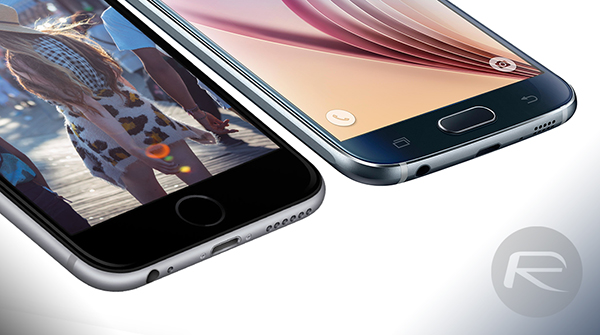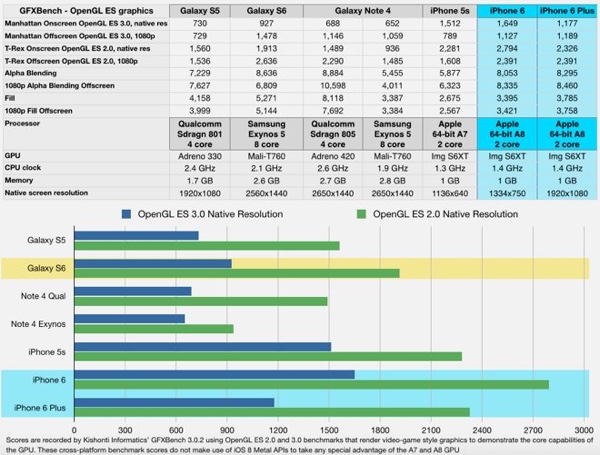According to a newly published set of test results, the Galaxy S6 with its octa-core processor finds itself bullied around by the iPhone 6 and iPhone 6 Plus with their dual-core chips and 1GB of RAM when it comes to graphics performance. Don’t believe us? Head over the jump for more details.
The Galaxy S6 is no doubt the best Android smartphone to come out of the Korean camp since a while, both on the design and performance front. The camera is brilliant, and so is the super-sharp Quad-HD display giving the phone a pixel density of 577ppi. However, this overkill of a display is what seems to be dragging down the performance of the phone in graphics intensive tasks.

As AppleInsider notes after conducting a series of performance tests on the Galaxy S6, the iPhone 6 and 6 Plus are clearly ahead of the super-phone from Samsung. All graphics performance tests based on various benchmarks show the significant hit that the Galaxy S6 is taking despite the fancy spec sheet the Korean giant touts.
iPhones have always been modest in the race to the latest specs, and Android devices are usually marketed and pitched as powerful and monstrous devices with their chunky CPU and GPU cores, RAM, and Quad-HD displays, but seldom has that threatened to out-perform iPhones and iPads.
“Samsung has pushed screen technology ahead of its own processor capabilities, resulting in extremely poor performance in high definition,” and interestingly it’s not just Samsung that has taken a hit from packing in more pixels in the display; “the iPhone 6 Plus resulted in graphics that were in some cases slower at their native resolution than 2013’s iPhone 5s: rendering a challenging OpenGL ES 3.0 3D scene dropped frame rates from 24.4 to 19.2 fps.”

The conclusion of the benchmark result is a simple one; as AppleInsider notes, Samsung has made “bad engineering choices,” and has opted to push better displays over key internal hardware, such as the GPU and CPU. And since the screen is bound to push more pixels around, like we mentioned before, the Galaxy S6 falls shorts in terms of performance when compared to the iPhone 6 and iPhone 6 Plus bundled with Apple’s second-gen 64-bit A8 chip, even though the Korean giant’s new flagship comes packed with 3GB of RAM – 2.6GB user available. The real winner for Apple here is the display, which is sharp enough to give users that undistinguishable pixel experience, and at the same time, keep performance as top-notch as possible. Lastly, Apple has the killer advantage of optimizing its software according to its hardware, giving it the edge over everyone else in the industry.
iPhones and iPads have always been in a league of their own when it comes to mobile gaming, and with the recent Metal technology being deployed in iOS 8, Apple is really pushing the boundaries of mobile graphics. At the end, Apple’s decision to stick to a pixel density that is not exactly overkill will continue to pay off pretty well against the likes of the Galaxy S6 with all its bling.
What’s your take on the matter? Share with us in the comments section below.
(Source: AppleInsider)
You can follow us on Twitter, add us to your circle on Google+ or like our Facebook page to keep yourself updated on all the latest from Microsoft, Google, Apple and the web.

